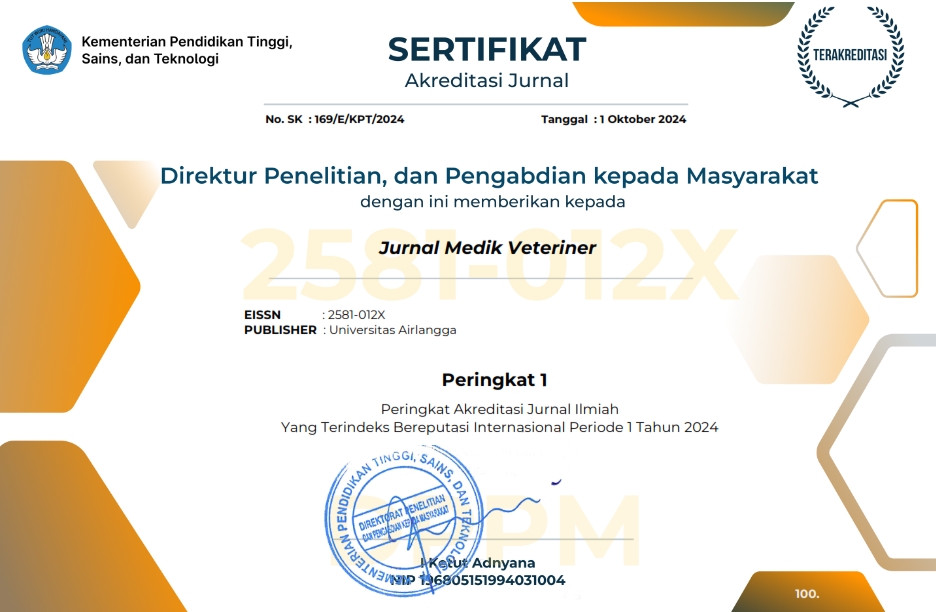Epidermal Growth Factor Promotes E6 and CCL-81 Vero Cells Proliferation Under Serum-Free Condition

Downloads
Vero cell culture as a platform for producing viral vaccines is an established and standardized process in vaccine manufacture. Generally, Vero cell culture requires media as a source of nutrition with serum supplementation to provide growth factors. However, the serum has several disadvantages including batch to batch variation and adventitious agent. Therefore, chemically defined serum-free media (SFM) are formulated by using standardized growth factors. Epidermal Growth Factor (EGF) is one of growth factors that showed adequate mitogenic support in serum-free medium system, especially in Vero cells. In this study, SFM-EGF media was compared with serum supplementation media, namely MEM 10% and MEM 5% FBS supplementation. The cell morphology was observed using an inverted microscope and their proliferation was evaluated using a MTT colorimetric-based assay. Vero E6 and Vero CCL-81 cells morphology did not show any morphological changes. Vero E6 and Vero CCL-81 proliferation in SFM-EGF media on day one to four did not show a significant difference compared to MEM 10% or MEM 5% serum supplementation media. However, the OD values of both Vero E6 and Vero CCL-81 cells given SFM-EGF media produced an average value below MEM 10% but higher than MEM 5% FBS supplementation. As such, this study proved that utilizing SFM-EGF could support the proliferation of Vero E6 and Vero CCL-81 cells.
Acosta, B. J., Cowley, G. J., Saura, L. P., Lopez, G. T., Santana, C. M., Mola, L. E., Nieto, G. G., & Martinez, H. L. (2009). Epidermal growth factor in clinical practice – a review of its biological actions, clinical indications and safety implication. International Wound Journal, 6(5), 331–346.
Boosntra, J., Rijken, P., Humbel, B., Cremers, F., Verkleij, A., & Henegouwen, B. P. (1995). The epidermal growth factor. Cell Biology International, (19), 413–430.
Chruszcz, M., Mikolajczak, K., Mank, N., Mejorek, A. K., Porebski, P., & Mino, W. (2013). Serum Albumims-Unusual allergens. Elsevier, 1830(12), 5375–5381.
Freshney, I. R., & Davis, C. A. (2010). Culture of Animal Cells, A Manual of Basic Technique and Specialized Application, 8th Edition. Wiley-Blackwell.
Ghasemi, M., Turnbull, T., Sebastian, S., & Kempson, I. (2021). The MTT Assay: Utility, Limitations, Pitfalls, and Interpretation in Bulk and Single-Cell Analysis. International Journal of Molecular Sciences, (22), 1–30.
Hamid, I. S., Ekowati, J., & Purnama, M. T. E. (2019). Kaempferia galanga L. Inhibiting Effect on Vascular Endothelial Growth Factor (VEGF) and Cyclooxygenase-2 (Cox-2) Expression on Endothelium of Chorioallantoic Membrane. Indian Veterinary Journal, 96(9), 80–82.
Hamid, I. S., Aksono, E. B., Sukmanadi, M., & Purnama, M. T. E. (2018). Antiangiogenesis activity test of tin leaf (Ficus carica L.) on the number of blood vessels and VEGF expression of chorioallantoic membrane of embryonated chicken eggs. European Journal of Oncology Pharmacy, 1(4), e00007.
Hashim, H. Z. Y., Mel, M., Salleh, M. H., Nor, A. Y., Othman, H. S., & Razak, A. H. Y. W. (2012). Serum in Mammalian Cell Culture: Weighing the Challenges of Bioprocessing, Ethics and Animal Welfare. Advances in Natural Applied Sciences, 6(5), 596–600.
Hyder, A., Ehnert, S., Hinz, H., Nussler, K. A., Fandrich, F., & Ungefroren. (2017). EGF and HB-EGF enhance the proliferation of programmable cells of monocytic origin (PCMO) through activation MEK/ERK signaling and improve differentiation of PCMO-derived hepatocyte-like cells. Biomed Central.
Jayaraman, S., Dave, M., Rajagopal, P., Rangsamy, B., Manjunathan, R., & Raktim, M. (2022). Chapter 3 Role of Animal Cell Culture in Vaccine Development. Cell Diagnostic and Research Center, pp: 29–44.
Jung, K., Kang, B. K., Kim, J. Y., Shin, K. S., Lee, C. S., & Song, D. S. (2008). Effects of epidermal growth factor on atrophic enteritis in piglets induced by experimental porcine epidemic diarrhea virus. The Veterinary Journal, 177, 231–235.
Kiesslich, S., & Kamen, A. A., (2020). Vero cell upstream bioprocess development for the production of viral vector and vaccines. Biotechnology Advances, 1.
Konishi, K., Yamaji, T., Sakuma, C., Kasai, F., Endo, T., Kohara, A., Hanada, K., & Osada, N. (2022). Whole-Genome Sequencing of Vero E6 (Vero C1008) and Comparative Analysis of Four Vero Cell Sublines. Frontiers, (13), 1–9.
Lee, K. D., Park, J., & Seo, W. D. (2020). Suspension culture of Vero cells for the production of adenovirus type 5. Clinical and Experimental Vaccine Research, 9(1), 48–55.
Meybosch, S., Monie, D. A., Anne, C., Bruyndonckx, J. A., Winter, D. Y. B., Trouet, D., & Ledeganck, J. K. (2019). Epidermal growth factor and its influencing variables in healthy children and adult. Plos One, 14(1), 1–13.
Petch, A. L., Harris, J., Raymond, W. V., Blasband, A., Lee, C. D., & Earp, S. H. (1990). Molecular and Cellular Biology, 2973–2982.
Posung, M., Promkhatkaew, D., Borg, J., & Tongta, A. (2021). Development of a modified serum free medium for Vero cell cultures: effect of protein hydrolysates, L-glutamine and SITE liquid media supplement on cell growth. Cytotechnology, (73), 683–695.
Shen, F. C., Guilbault C., Li X., Elahi M. S., Ansore S., Kamen A., & Gilbert R. (2019). Development of suspension adapted Vero cell culture process technology for production of viral vaccines. Elsevier, 37(47), 6996–7002.
Verma, A., Verma, M., & Singh, A. (2020). Animal tissue culture principles and applications. Animal Biotechnology, 14, 269–293.
Wee, P., & Wang, Z. (2017). Epidermal Growth Factor Receptor Cell Proliferation Signaling Pathways. Cancers, (9), 1–45.
Copyright (c) 2024 Diena Delaiah, Ahmad Aswin, Helen Susilowati, Andi Yasmin Wijaya, Firdausy Kurnia Maulana, Diyantoro Diyantoro, Watchareewan Rodprasert, Yulianna Puspitasari, Yeni Dhamayanti, Suryo Kuncorojakti

This work is licensed under a Creative Commons Attribution-NonCommercial-ShareAlike 4.0 International License.
Authors who publish in this journal agree to the following terms:
1. The journal allows the author to hold the copyright of the article without restrictions;
2. The journal allows the author(s) to retain publishing rights without restrictions;
3. The legal formal aspect of journal publication accessibility refers to Creative Commons Attribution-NonCommercial-ShareAlike 4.0 International License (CC BY-NC-SA).






11.jpg)




















